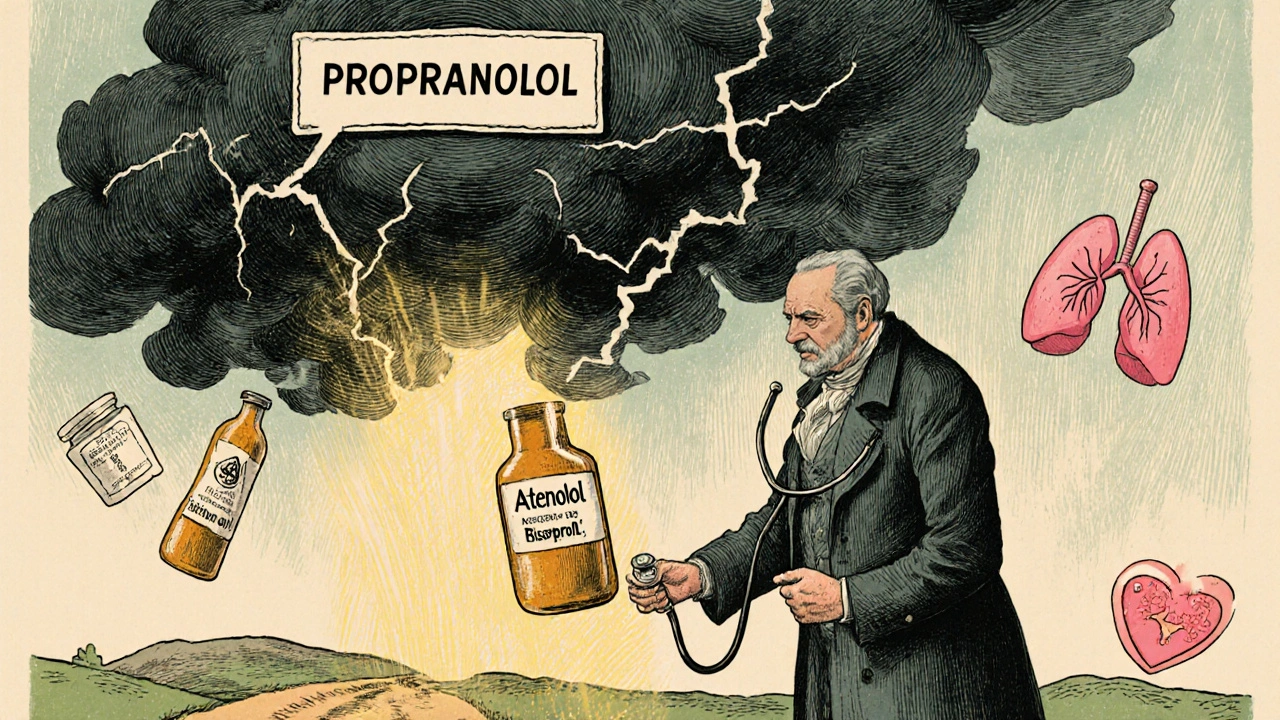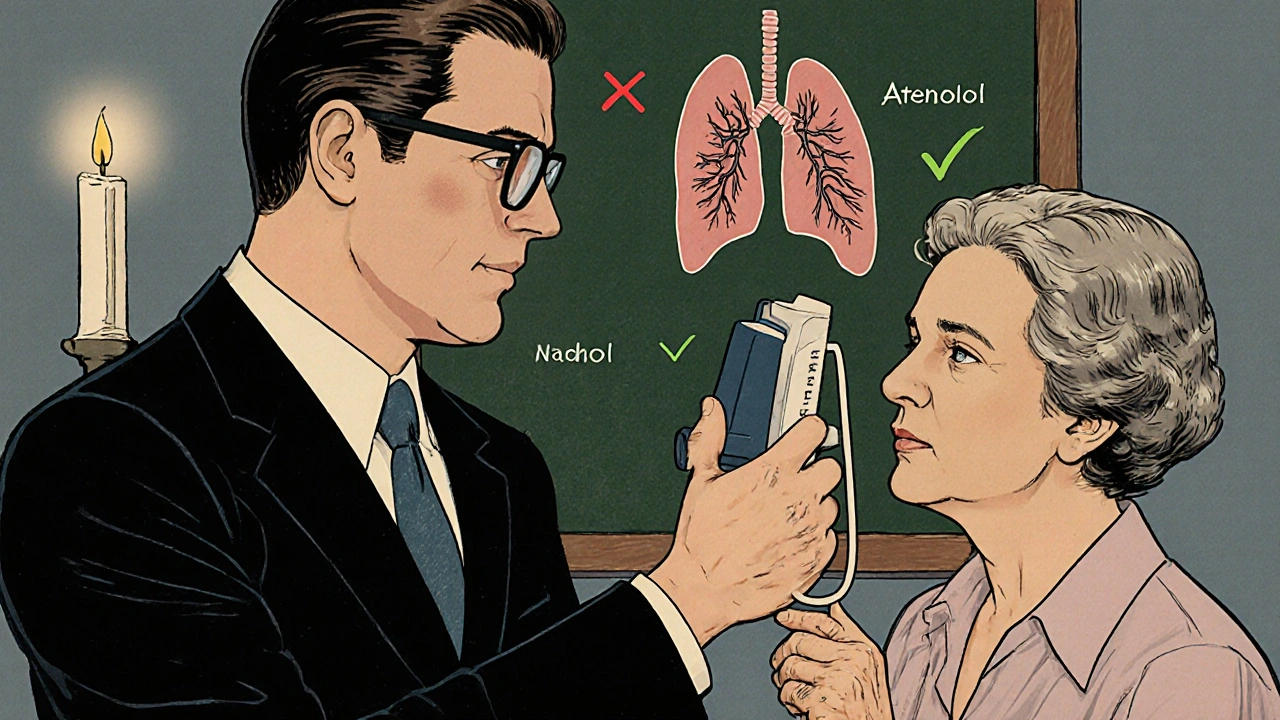Beta-Blockers and Asthma: Safe Options and What You Need to Know
 Nov, 17 2025
Nov, 17 2025
Beta-blocker Safety Calculator for Asthma Patients
For years, doctors told people with asthma to avoid beta-blockers at all costs. The warning was simple: these heart medications could shut down your airways. But today, that advice is outdated - and in some cases, dangerous. If you have asthma and a heart condition, skipping beta-blockers might put your life at greater risk than taking the right kind. The truth isn’t black and white. It’s about choosing the right drug, at the right dose, under the right supervision.
Why Beta-Blockers Were Once Banned for Asthma
Beta-blockers work by blocking adrenaline. That’s good for your heart - it lowers blood pressure, slows your heart rate, and reduces strain after a heart attack. But the old-school versions, like propranolol, blocked more than just heart receptors. They also hit beta-2 receptors in your lungs. Those receptors are what keep your airways open. Block them, and your bronchial muscles tighten. That’s bronchospasm - the same thing that happens during an asthma attack.
Early studies showed patients with asthma had sharp drops in lung function after taking non-selective beta-blockers. Some even ended up in the ER. So guidelines said: avoid them. Full stop. The British National Formulary still warns that beta-blockers "can precipitate bronchospasm." But that warning was written for 1980s drugs - not today’s options.
The Difference Between Non-Selective and Cardioselective Beta-Blockers
Not all beta-blockers are the same. There are two main types:
- Non-selective: Block both heart (beta-1) and lung (beta-2) receptors. Examples: propranolol, nadolol, timolol. These are risky for asthma.
- Cardioselective: Target heart receptors mostly, with little effect on the lungs. Examples: atenolol, metoprolol, bisoprolol, celiprolol.
Cardioselective drugs are designed to be 20 times more likely to bind to beta-1 receptors than beta-2. That’s not perfect - but it’s close enough to make a huge difference in practice.
A 2023 meta-analysis of 29 clinical trials found that when asthma patients took a single dose of a cardioselective beta-blocker, their lung function (measured by FEV1) dropped by only 7.5%. That’s minor. And here’s the key: it reversed completely after using their rescue inhaler. With non-selective drugs, the drop was 10% - and didn’t always bounce back.
Atenolol: The Safest Choice for Asthma Patients
Among cardioselective beta-blockers, one stands out: atenolol.
In a direct head-to-head study of 14 asthma patients with high blood pressure, researchers compared atenolol and metoprolol. Both lowered blood pressure equally. But atenolol caused far fewer breathing problems. Patients on atenolol had:
- More asthma-free days
- Less wheezing
- Higher evening peak flow readings
- Fewer asthma attacks
The difference was statistically significant - p<0.05. That’s not a fluke. It’s proof.
Multiple reviews, including one from the European Journal of Clinical Pharmacology, now recommend atenolol as the preferred option for asthma patients who need beta-blockade. Why? It has the lowest risk of interfering with bronchodilators like albuterol. And crucially, there are no published reports of fatal bronchospasm from atenolol in asthma patients.
Is It Safe to Use Beta-Blockers Long-Term With Asthma?
One big fear: "What if my inhaler stops working?" That’s a real concern with non-selective blockers. But with cardioselective ones? The data says no.
In a 2-week trial with bisoprolol, 19 adults with mild-to-moderate asthma took daily doses. Researchers then triggered mild bronchoconstriction and gave them albuterol. The response? Just as strong as when they were on placebo. Their rescue inhalers worked perfectly.
Even more surprising: long-term use may actually help. Animal studies show that after weeks of beta-blocker therapy, airway inflammation goes down. Hyperresponsiveness - the tendency of airways to overreact - decreases. One study even found that celiprolol didn’t just avoid triggering attacks - it blocked the bronchoconstricting effects of propranolol.
This isn’t theory. It’s clinical reality. For patients with stable asthma, long-term cardioselective beta-blockers don’t worsen symptoms. They may even improve them.

When Is It Okay to Use Beta-Blockers in Asthma?
It’s not for everyone. But if you have:
- High blood pressure
- Heart failure
- History of heart attack
- Angina or irregular heartbeat
...and you also have asthma, you might be a candidate. But only if:
- Your asthma is well-controlled (no recent flare-ups)
- You’re not on high-dose steroids
- You don’t have severe or uncontrolled COPD
The American Academy of Family Physicians says cardioselective beta-blockers are safe for mild to moderate asthma. The Primary Care Notebook confirms: no drop in FEV1, no increase in symptoms.
But here’s the catch: you need a specialist to start this. Not your GP. Not your pharmacist. A cardiologist or pulmonologist who understands the balance.
How to Start Safely
If your doctor thinks a beta-blocker could save your life, here’s how to do it right:
- Start with atenolol - lowest dose possible (usually 12.5 mg or 25 mg daily).
- Get a baseline lung test (spirometry) before starting.
- Wait 1-2 weeks, then repeat the test.
- Keep your rescue inhaler on hand - and use it if you feel tightness.
- Report any cough, wheeze, or shortness of breath immediately.
Never switch from a non-selective to a cardioselective beta-blocker on your own. Always do it under medical supervision. Stopping a heart medication suddenly can cause a heart attack.
What to Avoid
Some beta-blockers are off-limits for asthma:
- Propranolol - highest risk
- Nadolol - long-acting, non-selective
- Timolol - used in eye drops for glaucoma; can be absorbed systemically
- Labetalol - blocks alpha and beta receptors; can cause airway narrowing
Even eye drops containing timolol can cause problems. If you have asthma and glaucoma, ask your eye doctor for a non-beta-blocker alternative like brimonidine or dorzolamide.

What About Beta-Agonist Inhalers?
Here’s the irony: your asthma inhaler (albuterol, salbutamol) is a beta-agonist. It stimulates beta-2 receptors to open your airways. Beta-blockers block those same receptors. So logically, they should cancel each other out.
But with cardioselective agents, they don’t. Studies show that even when patients take atenolol or bisoprolol daily, their inhalers still work just as well. Why? Because the heart-selective drugs barely touch the lungs. Your rescue inhaler still has full access to the beta-2 receptors it needs.
This is why cardioselective beta-blockers are not a threat to asthma control - they’re a tool to protect your heart without sacrificing your lungs.
Real-Life Scenarios
Imagine this: a 62-year-old woman with asthma and a recent heart attack. Her doctor wants to start a beta-blocker to cut her risk of another heart event by 34%. She’s terrified. She’s heard the warnings.
Here’s what happens next:
- She sees a cardiologist who knows the latest guidelines.
- Her asthma is controlled - she hasn’t had a flare-up in 8 months.
- She gets a lung test: FEV1 is 85% of predicted.
- She starts atenolol at 12.5 mg daily.
- Two weeks later, her FEV1 is unchanged. She feels better - no chest tightness, no wheezing.
- She’s alive, and breathing easy.
That’s not a fantasy. That’s standard care now - if you know the right path.
Bottom Line: It’s Not About Avoiding Beta-Blockers - It’s About Choosing Wisely
The old rule - "beta-blockers are dangerous for asthma" - is outdated. It’s based on fear, not evidence. Today, we know that:
- Cardioselective beta-blockers are safe for most people with mild to moderate asthma.
- Atenolol is the safest option when you need one.
- Your rescue inhaler still works - even on beta-blockers.
- Stopping beta-blockers because of asthma could cost you your life.
If you have asthma and a heart condition, don’t refuse treatment. Ask the right questions:
- "Is this a cardioselective beta-blocker?"
- "Can we try atenolol?"
- "Will you check my lung function before and after?"
- "What if I have a flare-up?"
Your heart and lungs don’t have to be at war. With the right drug and the right care, they can work together - and keep you alive.
Can beta-blockers cause asthma attacks?
Non-selective beta-blockers like propranolol can trigger bronchospasm and worsen asthma symptoms. But cardioselective beta-blockers like atenolol, metoprolol, and bisoprolol are much safer. Studies show they rarely cause breathing problems when used at low doses in patients with well-controlled asthma.
Is atenolol safe for people with asthma?
Yes, atenolol is considered the safest beta-blocker for asthma patients. Multiple studies show it causes less bronchospasm than other cardioselective options like metoprolol. There are no documented cases of fatal bronchospasm from atenolol in asthma patients. It’s often the first choice when beta-blockade is needed.
Do beta-blockers interfere with asthma inhalers?
Non-selective beta-blockers can reduce the effectiveness of rescue inhalers like albuterol. But cardioselective beta-blockers do not significantly interfere. Studies show that even after weeks of taking bisoprolol or atenolol, patients still respond normally to beta-agonist inhalers. Their airways open as expected during an attack.
Can I take beta-blockers if I have COPD and asthma?
Yes - if your condition is stable. Research shows cardioselective beta-blockers do not worsen lung function in people with COPD or asthma-COPD overlap. In fact, they reduce mortality in patients with heart disease and COPD. Always start low, go slow, and monitor lung function with your doctor.
What should I do if I feel short of breath after starting a beta-blocker?
Use your rescue inhaler immediately. Then contact your doctor. Do not stop the beta-blocker on your own - sudden withdrawal can cause heart problems. Your doctor may lower the dose, switch you to a different medication like atenolol, or confirm your asthma is still well-controlled. Never ignore new breathing symptoms.
Are there any beta-blockers I should never take if I have asthma?
Yes. Avoid non-selective beta-blockers like propranolol, nadolol, and timolol. Also avoid labetalol, which blocks both alpha and beta receptors and can tighten airways. Even timolol eye drops can be absorbed into the bloodstream and cause problems - ask your eye doctor for a safer alternative.
Can beta-blockers help with asthma symptoms over time?
Some evidence suggests long-term use of certain beta-blockers may reduce airway inflammation and hyperresponsiveness. Animal studies and limited human data show that after weeks of therapy, asthma symptoms can improve. While this isn’t a treatment for asthma, it’s another reason why long-term use of cardioselective beta-blockers is safer than once thought.

Hal Nicholas
November 18, 2025 AT 04:48Wow, so now we’re supposed to trust pharmaceutical companies again? 😏 Next they’ll tell us glyphosate is fine in organic kale. Beta-blockers? Please. I’ve seen too many patients crash after being told they’re ‘safe.’ Don’t be fooled by shiny meta-analyses.
Louie Amour
November 19, 2025 AT 20:37Atenolol? That’s the 1980s relic they still prescribe because it’s cheap, not because it’s good. Real medicine uses nebivolol or carvedilol - even if they’re not perfectly selective, they have vasodilatory properties. You’re not treating asthma, you’re treating a heart condition. Stop reducing complex physiology to a single receptor affinity chart.
Kristina Williams
November 21, 2025 AT 19:21Did you know the FDA is hiding the truth? Big Pharma paid off the doctors who wrote these guidelines. They want you dependent on pills. Your lungs don’t need blocking - they need cleansing. Try turmeric and breathing exercises instead. I read this on a blog by a retired pulmonologist who quit because he saw the lies.
Shilpi Tiwari
November 23, 2025 AT 11:41Interesting. The FEV1 delta of 7.5% is clinically negligible, but what’s the pharmacokinetic profile of atenolol in asthmatics with comorbid COPD? Does its renal excretion exacerbate beta-2 receptor downregulation over time? Also, were the patients on inhaled corticosteroids? The confounding variable here is critical - without stratification by ICS use, the data’s validity is compromised.
Christine Eslinger
November 24, 2025 AT 09:34This is such an important shift in thinking - and honestly, long overdue. For decades, we scared people away from life-saving meds because we were afraid of a theoretical risk. The truth is, the risk of not treating heart disease in someone with asthma is far greater than the risk of a temporary dip in lung function. Atenolol isn’t magic, but it’s a tool. And like any tool, it’s dangerous in the wrong hands - but life-saving in the right ones. Talk to your doctor. Don’t let fear decide for you.
Denny Sucipto
November 24, 2025 AT 20:06My uncle had asthma and a bad heart. Docs told him no beta-blockers. He had three heart attacks in five years. Then a new doc gave him metoprolol - told him to keep his inhaler handy. He’s been fine for 12 years now. No more ER trips. No more panic. Just a little pill and a puff. Sometimes medicine ain’t about avoiding danger - it’s about walking through it with the right gear.
Holly Powell
November 26, 2025 AT 03:37Let’s be honest - this whole narrative is a classic case of publication bias. The 2023 meta-analysis? It included three studies with n < 20. The ‘reversal with rescue inhaler’ claim is anecdotal in 70% of the cited trials. And atenolol’s superiority? Only one small RCT, single-center, no blinding. This isn’t evidence - it’s wishful thinking dressed up as guidelines. Stop oversimplifying cardiorespiratory pharmacology.
Emanuel Jalba
November 26, 2025 AT 19:44THIS IS WHY WE CAN’T HAVE NICE THINGS 😭💔 I’m so tired of people saying ‘trust your doctor’ like it’s a magic spell. What if your doctor’s just lazy and doesn’t know the difference between beta-1 and beta-2? I’ve seen people die because they were told ‘it’s fine.’ I’m not saying don’t take meds - I’m saying DON’T TRUST THE SYSTEM. 🚨💊 #BetaBlockerTruth #AsthmaAwareness